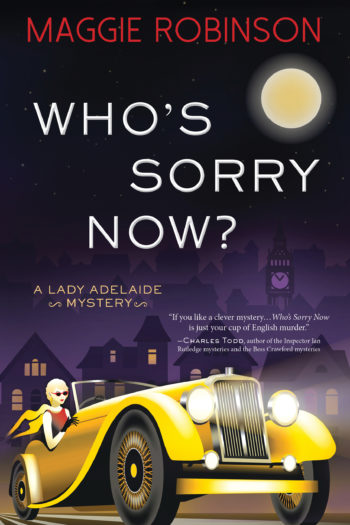 WHO’S SORRY NOW? is the second installment in Maggie Robinson’s 1920s mystery series featuring Lady Adelaide Compton, a marquess' daughter and widow of a Great War hero. Set in the fictional Thieves’ Den --- which, according to the author, is “the place to dance, drink, drug and possibly purchase poison so one could go on a punishing killing spree” --- the novel revolves around a series of upper-class deaths in London, as Bright Young People are being extinguished in their favorite night spots. After reading this blog post from Maggie about the Twenties, you will want to experience this rollicking era --- famous for its excesses and extravagance, cocktails and music ---for yourself in the pages of her books.
WHO’S SORRY NOW? is the second installment in Maggie Robinson’s 1920s mystery series featuring Lady Adelaide Compton, a marquess' daughter and widow of a Great War hero. Set in the fictional Thieves’ Den --- which, according to the author, is “the place to dance, drink, drug and possibly purchase poison so one could go on a punishing killing spree” --- the novel revolves around a series of upper-class deaths in London, as Bright Young People are being extinguished in their favorite night spots. After reading this blog post from Maggie about the Twenties, you will want to experience this rollicking era --- famous for its excesses and extravagance, cocktails and music ---for yourself in the pages of her books.
Bright Young Things or Bright Young People? It rather depends on which side of the Atlantic you hung your stolen bobby’s hat during the rollicking 1920s. The appellation BYP was preferred in Britain, and described the group of rich, reckless, rootless and sometimes ridiculous 20-somethings who were enjoying the Twenties with absolute abandon. In the words of F. Scott Fitzgerald: “The parties were bigger. The pace was faster, the shows were broader, the buildings were higher, the morals were looser, and the liquor was cheaper.”
The Twenties are famous for their excesses and extravagance, but behind all the gloss was the dark shadow of the Great War. Nearly an entire generation of young men were wiped out, and those who survived meant to make every moment count. Those too young to fight had still suffered through hardship and deprivation, and there was a manic quest for amusement throughout much of society. Themed costume parties were highly popular --- guests dressed as infants in bonnets, were pushed in prams, and swigged gin from baby bottles. There were pajama parties. Swimming parties. Nearly naked parties. Come as you were 20 years ago. Elaborate scavenger hunts were also in vogue --- and hence, that stolen bobby’s hat (even Bertie Wooster succumbed) or baton. Nothing was too silly or senseless. And if it upset the parents or high society? All the better.
 This was the era of the cocktail, whose mixture of fruit and fizz often disguised inferior alcohol (which came in particularly handy in the States during Prohibition, where one might be distilling one’s own bitter concoction in the family bathtub). At least there was easily accessible liquor in the UK, and lots of it to be had in private clubs springing up throughout London. I’ve set the second Lady Adelaide Mystery, WHO’S SORRY NOW?, in the fictional Thieves’ Den, the place to dance, drink, drug and possibly purchase poison so one could go on a punishing killing spree.
This was the era of the cocktail, whose mixture of fruit and fizz often disguised inferior alcohol (which came in particularly handy in the States during Prohibition, where one might be distilling one’s own bitter concoction in the family bathtub). At least there was easily accessible liquor in the UK, and lots of it to be had in private clubs springing up throughout London. I’ve set the second Lady Adelaide Mystery, WHO’S SORRY NOW?, in the fictional Thieves’ Den, the place to dance, drink, drug and possibly purchase poison so one could go on a punishing killing spree.
As well as being the era of cocktails, the Twenties are a golden age of music. Each book in the Lady Adelaide series shares a title with a popular song from the decade. (I might always associate “Who’s Sorry Now?” with the peerless Connie Francis, but the song was written in 1923!)
Those of us in the U.S. associate organized crime with the Twenties as well, and it was no different in Great Britain. Vice ruled. In the course of my research, I discovered an unlikely girl gang: the Forty Elephants. Though the name is hardly flattering, it’s believed to have come about since so many of the young women came from the Elephant and Castle district. These glamorous bad girls were absolutely brazen, working in groups to distract salesmen and walking out with trays of jewels or fur coats stuffed under their skirts.
When the Metropolitan Police made things too difficult in Town, the girls went elsewhere throughout the kingdom and stole anything that wasn’t nailed down. My Thieves’ Den was the perfect spot for my imaginary “Forty Dollies” to wear their ill-gotten gains and dance their nights away. The strict rules of society were bending, and if you were young and beautiful and bold, London nightlife and its 11,000 nightclubs beckoned to all classes. The Prince of Wales (later the Duke of Windsor) narrowly missed getting caught in a raid himself.
Enter my protagonist Lady Adelaide, who feels much too old and conventional for such nonsense (even though she’s only 31 ½). She is acting as a reluctant chaperone to her younger sister, Cecilia, and the two of them fall in with a crowd of idle young rich people in 1925 London. But when Cee is accidentally poisoned, Addie knows Detective Inspector Devenand Hunter will get to the bottom of the Bright Young Problem, with a little help from her late and unlamented husband Rupert. The ghostly Rupert has been assigned (from on high) to perform some good deeds to make up for all the heartache he caused while he was a charming cad. Among the three of them, one thing is certain --- justice and jazz will prevail!


